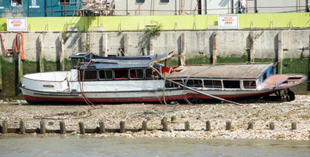
The Marchioness disaster was a collision between two vessels on the River Thames in London in the early hours of 20 August 1989, which resulted in the deaths of 51 people. The pleasure boat Marchioness sank after being hit twice by the dredger Bowbelle at about 1:46 am, between Cannon Street railway bridge and Southwark Bridge.
Marchioness had been hired for the evening for a birthday party and had about 130 people on board, four of whom were crew and bar staff. Both vessels were heading downstream, against the tide, Bowbelle travelling faster than the smaller vessel. Although the exact paths taken by the ships, and the precise series of events and their locations, are unknown, the subsequent inquiry considered it likely that Bowbelle struck Marchioness from the rear, causing the latter to turn to port, where she was hit again, then pushed along, turning over and being pushed under Bowbelle's bow. It took thirty seconds for Marchioness to sink; 24 bodies were found within the ship when it was raised.
An investigation by the Marine Accident Investigation Branch (MAIB) blamed a lack of lookouts, but their report was criticised by the families of the victims, as the MAIB had not interviewed anyone on Marchioness or Bowbelle, but relied on police interviews. The government refused to hold an inquiry, despite pressure from the families. Douglas Henderson, the captain of Bowbelle, was charged with failing to have an effective lookout on the vessel, but two cases against him ended with a hung jury. A private prosecution for manslaughter against four directors of South Coast Shipping Company, the owners of Bowbelle, and corporate manslaughter against the company was dismissed because of lack of evidence.
A formal inquiry in 2000 concluded that "The basic cause of the collision is clear. It was poor lookout on both vessels. Neither vessel saw the other in time to take action to avoid the collision."[1] Criticism was also aimed at the owners of both ships, as well as the Department of Transport and the Port of London Authority. The collision and the subsequent reports led to increased safety measures on the Thames, and four new lifeboat stations were installed on the river.
- ^ Clarke 2001a, p. 367.
© MMXXIII Rich X Search. We shall prevail. All rights reserved. Rich X Search
